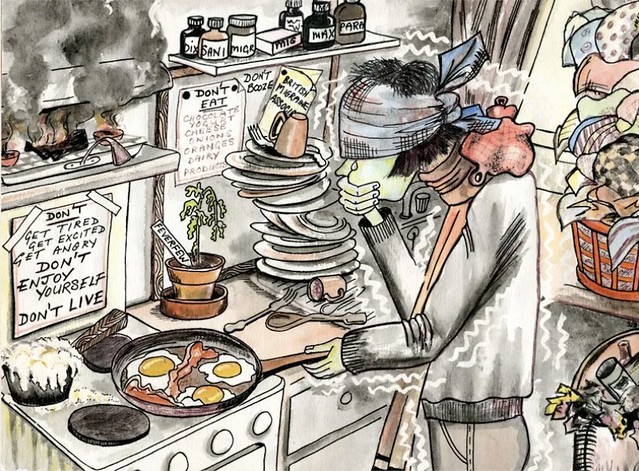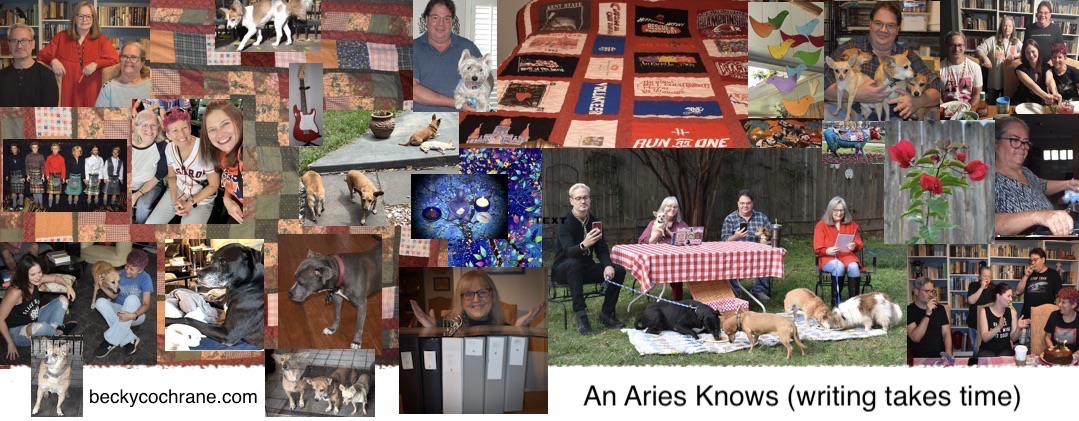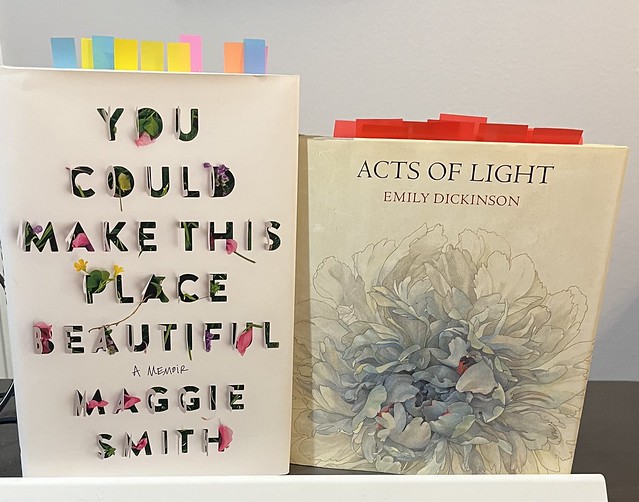
Forbidden things and kitchen chaos
Artist unknown, from North East England
painting, 1985
available for public use from the Wellcome Collection’s Migraine Art Competition Collection
Joan Didion describes her experience with migraines in this excerpt from The White Album. When I found the above art on line, she was referenced. I’ve read the book but had no memory of the excerpt. I think my compassion for/identification with anyone who suffers migraines is so acute that I try not to hold on to their descriptions.
An online search for art relating to migraines shows a sad wealth of how people experience the illness. I was in ninth grade when I had my first, and it was terrifying, with complete numbness beginning down one side of my face before traveling down that half of my body. I was fifty percent skull-to-toe numb, which made movement challenging. My vision was impaired; I couldn’t string coherent sentences together. Emotionally, I was shaken then scared. I was supposed to be baking a chocolate pound cake, a home ec assignment, and I ceased being able to reason or function. I couldn’t read the recipe or measure out ingredients. My mother, aggravated because I couldn’t make words to explain what was happening, sent me to bed and finished the cake. (I still have and use that recipe from the index cards I used in class to write it down. It’s delicious, and I always think of it as my big fuck-you to migraines.)
I’m not sure when that episode repeated. It struck infrequently, without warning, and I was usually able to mask that anything was happening. It wasn’t like I had a job or had to drive or take care of anyone else. I might complain of a headache when I turned down invitations from friends, but mostly I kept it private. It was the only part of my life that became easier when my parents made me transfer schools. The friends who knew me best didn’t spend every day with me anymore. They weren’t driving yet either, so the most I might get other than an occasional weekend outing, or a sleepover with Lynne, was a visit from Riley, who did have his license because he was a year older. At the new school, I had a single genuine friend (the nephew of my first boyfriend from my other school; though the boyfriend, too, was a year older and could have driven to see me, we were on a break, one of many over several years). Though there were a few students with whom I had semi-friendly relationships, I had no after-school social life my sophomore year. (ETA: Things got… moderately better my last couple of years of high school thanks to the school paper, Color Guard, good teachers, and some new friends.)
I finished high school, went to college. I became more open about my occasional migraines with friends, and I found hit-or-miss ways to deal with them. From my mid-twenties on, they took a new form: a once-monthly event with different pain sensations and no identifiable common triggers. In my early thirties, at a meetup with a friend from junior high in our small town, she told Lynne and me about her migraines, vastly worse than my own. Her doctors tried one treatment after another until they finally gave her a hysterectomy. It was a drastic and not always effective solution, but she had no regrets. She finally had a much higher quality of life with her husband and two young children and a job she enjoyed.
Because of her, I finally recognized the pattern of my migraines, which had become more frequent. They didn’t come every month, but when they happened, they generally fell somewhere in the middle between my monthly cycles. Just being able to latch on to an answer, hormones as a possible cause, afforded me relief. I accepted that I would have four to six days a month in pain. I’d have to avoid driving, sunlight, and noise. If possible, I’d spend as much time as I could in a dark room, avoid television or music, and eat only bland foods. Food with strong smells were torment.
Since I had to be at jobs despite migraines–life doesn’t stop–I learned that if I were surrounded by my favorite coworkers, the ones who made me laugh, pain didn’t go away, but it took a backseat. The vision problems were-are–temporary. By then, Tom and I were married, and unlike a couple of the previous men in my life, he never treated me like I was acting crazy, or faking, or attention seeking. He took care of me in ways that were helpful and otherwise left me alone. He’d known other people with chronic illnesses, and he’s also a self-sufficient human adult. It makes a huge difference.
Post-menopause, the regularity of migraines tapered off. They still happen. They can still rob me of time and energy, but they more often manifest as vision problems without the excruciating headaches. During even the mildest migraine events, I still avoid light. I still can’t stand strong food odors.
This particular painting resonated. I thought of all the times I had to keep functioning no matter how I felt. The simplest tasks would feel overwhelming, my time out of my control, plus migraines involved constant trial and error: what worked or made things worse could change from episode to episode.
I know an artist who donates his time at a hospital leading step-by-step painting sessions as part of a cancer support group. What a wonderful gift he provides. I know people who color, knit, play an instrument, or find other creative ways to work their way through the fear, pain, and anxiety of illness. I couldn’t have written–I still can’t–my way through a migraine. I also can’t bear the eyestrain of reading. I wonder, during my years of adolescence or early adulthood, if some kind of creative outlet, or creative self-expression, might have helped me navigate the pain. I know from other artists’ experiences that it likely couldn’t have eliminated pain, but it might have made those lost days more bearable.
If you read here, or accidentally stumble over this post, I don’t have much wisdom to offer. I hope that when you can’t function, you know that it’s not a failure of character. Sometimes it’s everything you can do to get through a bad day or night. Even when you have good friends, family, healthcare, partners, or roommates, illness can be a lonely place. Please show yourself some grace, some tolerance, some patience, and do what you can to find what works and avoid what doesn’t when you’re going through a health event.
One of my own biggest struggles remains: not reproaching myself or feeling resentful about time and activities lost when I’m sick. I’m an old work in progress.

 Also on Sunday, I colored a page in my coloring journal. Below is the coloring page, and a quote from the facing page. My eye surgery was scheduled for today, and I wanted a distraction and a way to think positively (after all, note the name of the journal, gift of Lynne), and to make note of my anticipation of surgery.
Also on Sunday, I colored a page in my coloring journal. Below is the coloring page, and a quote from the facing page. My eye surgery was scheduled for today, and I wanted a distraction and a way to think positively (after all, note the name of the journal, gift of Lynne), and to make note of my anticipation of surgery.


















